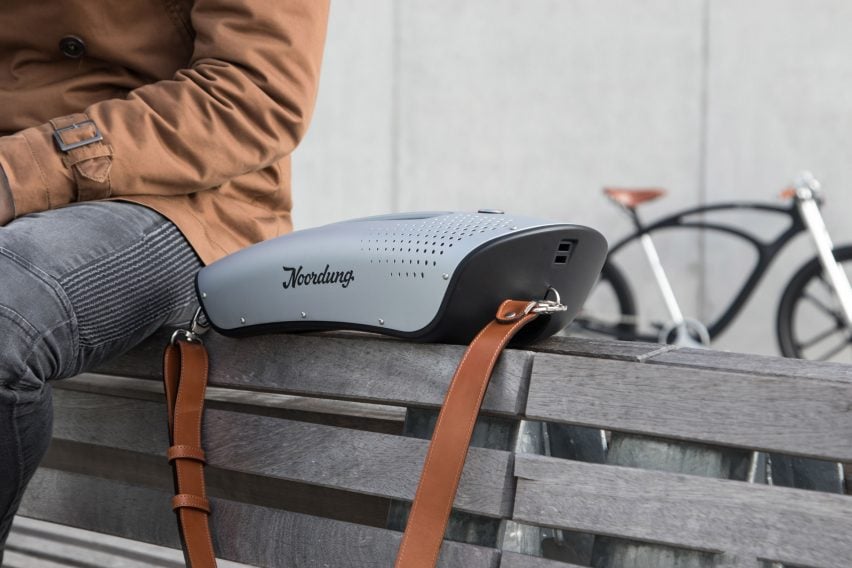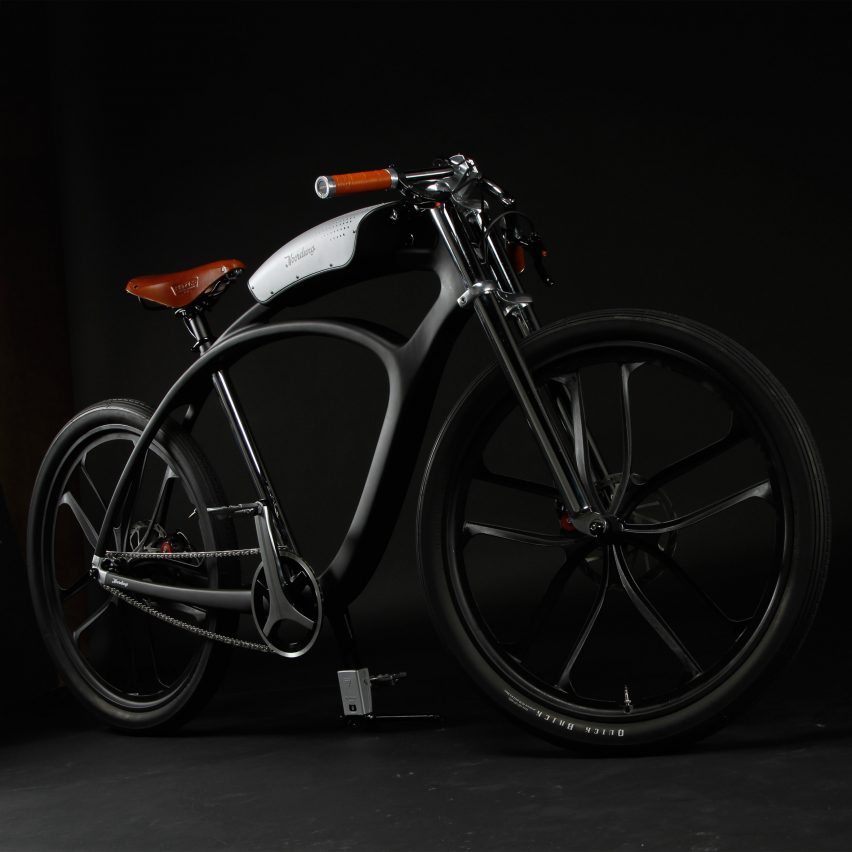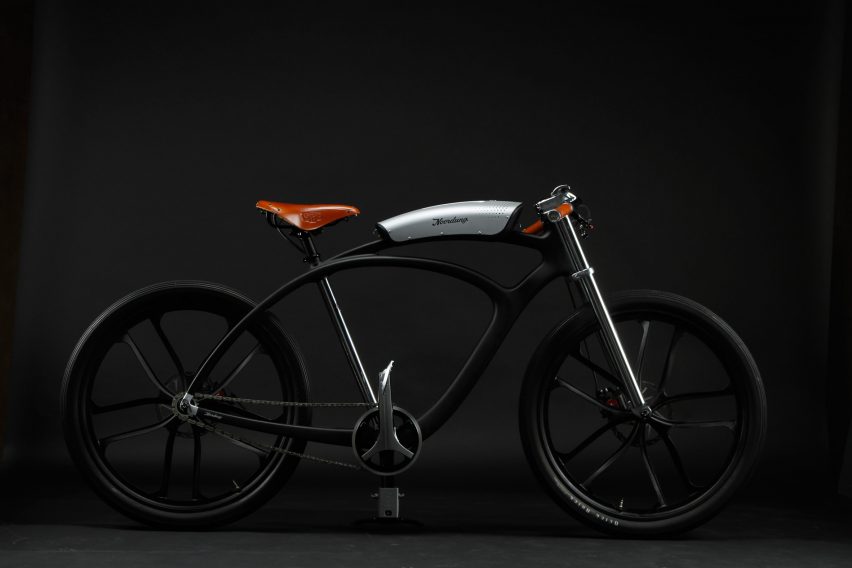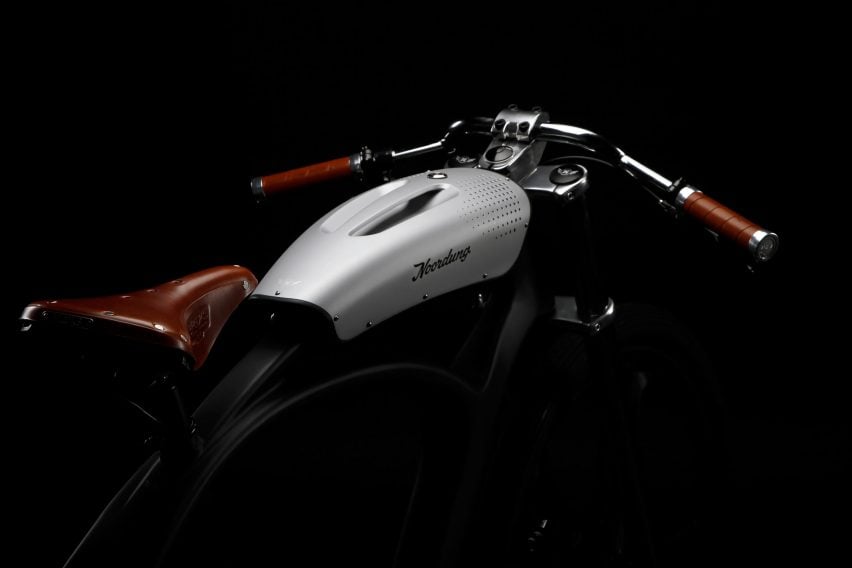Materials library
Academy Eindhoven
Design Academy Eindhoven graduate Milou Bergs has designed a bicycle rack that only pops-up when needed, as an alternative to the "eyesore" storage systems populating towns and cities.
Bergs' Align project addresses the look of functional street furniture and the effect it has on public spaces.
Having studied in the Netherlands – a country famous for its volume of cyclists – Bergs focused her project on improving bicycle parking, aiming to find an alternative to the robust metal racks located around cities and towns.
"Bicycle racks are a particular eyesore," Bergs told Dezeen. "Even when not in use, they get in the way, creating physical and visual noise."
"I started to think about how I could make a space visually and physically serene while keeping the functionality of storage," she continued.
Bergs' bicycle rack works using a pop-up mechanism. When the weight of the front wheel is applied to a panel on the floor, a bracket raises up and locks onto the back wheel – securing the bike in place.
When the bicycle is removed, the rack "disappears entirely", and is hidden flat inside the pavement.
For Bergs, the intention behind this is to keep public spaces open and clear of excess objects.
"[It] means that public spaces can once again be open, making room for events, markets or everyday life," Bergs explained.
The design has already attracted the attention of Dutch municipalities, which have – according to the designer – shown interest in implementing the design into public spaces.
"It can be implemented on a larger scale once I have developed the bicycle rack in collaboration with a production company," she said. "At the moment I am researching and discussing the possibilities."
As the volume of bicycles in public spaces continues to increase, designers have come up with innovative ideas to utilise their impact on cities, including a bicycle that generates clean air as you pedal and a community bicycle that doubles as a mobile farm.
Bergs' Align project was presented at the Design Academy Eindhoven graduation show, which was taking part during this year's Dutch Design Week.
Baik
Spanish designer Ion Lucin has created a concept for a minimal bicycle with a slender frame, three-spoke wheels and brightly coloured highlights (+ slideshow).
The Baik's orange accents are partially hidden on the inside edges of the matte black frame, and are only visible from certain angles. The wheels each feature three spokes and are designed with ultra-thin tyres in mind.
"The idea was to create a bicycle design with as few elements and lines as possible," said Lucin. "With the help of symmetrical lines and angles it was possible to create a frame which would blend with the rims of the bicycle in the same angle, thus even further eliminating the lines that were present."
The bike is a fixed-gear model, and features horizontal handlebars with minimal details. The concept design also includes plans for a satchel-style bag, which can be attached to the frame.
The bag features a fold-over opening with two fastenings, and a slanted front section that allows it to be aligned with the bike's downtube.
Lucin has designed concepts for further accessories that could accompany the bike, including a wallet, sunglasses and a watch – all decorated with the signature orange detailing.
He also created a bespoke three-dimensional typeface for Baik, which includes purposefully incomplete numbers and letterforms and has been used for the bike's orange-accented logo.
Several designers have reinterpreted standard bikes, often using non-traditional materials in the process.
Niko Schmutz layered oak veneer to create a concentric diamond-shaped frame, while Paul Timmer designed a cycle made from solid ash and 3D-printed aluminium parts.
Materials Research
Aluminium
When aluminum alloys were first commercialized at the end of the nineteenth century they were a new and aspirational material. Used for applications such as cutlery and dinnerware, aluminum was seen as having greater status even than gold and was around twice the cost. In the 1950s aluminum went through another period of promotion, when its light weight and strength were applied to buildings and iconic vehicles such as the Airstream caravan. Like plastic, which has followed a similarly progressive series of interpretations and associations, aluminum still maintains its value as a material but with embedded aspirational values and, together with magnesium and titanium, is a part of the trio of lightweight metals. It's lightweight qualities were exploited in its use as the material for the 2012 Olympic torches.
In little over a century, this relatively new addition to the family of metals has become one of the world's most widely used metals, second only to steel. With its winning combination of strength, low weight and resistance to corrosion, aluminum has become the optimum metal for all kinds of transportation applications, including ocean liners, aircrafts and even spaceships. When ground into a powder form, aluminum is one of the few metals that retains a shiny appearance, which is why it is commonly found in paints and plastics, where it is used to produce a metallic effect. Aluminum is 100 per cent recyclable, and nearly three-quarters of all aluminum ever made remains in use today!
Carbon Fibre
Carbon exists in both crystalline and amorphous forms, which goes some way to explain how, in a single substance, a vast array of materials ranging from graphite to carbon fibre with opposing properties can be arrived at Amorphous materials have no definite shape. they break to give curved or irregular faces, and they also soften and will melt over a specific temperature range. Crystalline material. Consist of individual crystals, and are arranged in a well-defined shape.
Although it originates from the same dement a diamond, carbon fibre is one of the new man-made high-tech materials that has come to be associated with premium, high-end luxury. Consisting of shin black filaments of fibers drawn from approximately 90 per cent carbon it is renowned as a high performance material with aspirational qualities. These associations also because of its high tensile strength. Although in products like high-end pens. the tens k strength is not of huge benefit, it is worth noting that in comparison to a human hair, which has a tensile strength of 380M Pa, carbon fibers-at 4137 Mpa- have one of the highest tensile strengths of any widely used material. This is partly because of its atomic structure.
Unlike the layered, chicken-wire structure of graphite another foe of carbon-carbon fibres consist of ribbons of carbon atoms aligned parallel to the axis of the fibres, giving i its supreme strength
Steel
Arguably, one of the most important materials the world is steel, which strikes the balance between strength, easy forming and being very cheap. Steel is a material that evokes associations with heavy industry out to really understand steel and its value to the world, one should think of it as a raw material from which a whole range of derivatives, with different nuances, can be formed.
Steel is obtained by alloying iron with small amounts of carbon. It is the inclusion of carbon in varying degrees and the way oxygen is allowed to es properties of the vast number of grades of steel that can be formed. These steel grades can be broadly split into two main groups: carbon steels and alloy steels Within the branch of carbon steels there are further broad categories including mild steel, medium and high carbon steels, The lower the carbon content, the milder the steel but also the tougher; the higher the carbon, the harder the steel (i. e stays shaped for longer) until you reach about 4 percent carbon, at which point the metal becomes cast iron.
Cold working steel increases its strength and decreases ductility and, like aluminum, steels can be alloyed to increase their physical properties. These alloys include lead to increase machinability, cobalt which increases hardness at high temperatures, an nickel, which increases toughness. Like aluminum steel is classified by the use of four digits
Titanium
I used to have has a neoprene wetsuit with the word 'titanium' pasted across the arm. Like so many materials with high-grade properties titanium, when it is applied to consumer facing products, fits into our modern day obsession with advanced materials which sometimes goes just a little bit too far. The advanced profile of titanium has grown since its commercial introduction in the 1950s due to its use in high-tech applications that exploit its incredibly high strength-to-weight ratio.
Discovered by the British chemist Reverend William Gregor in 1791, titanium i for the. Greek god Titan, the incarnation of natural strength. It is the ninth most abundant element on earth and has the highest strength-to-weight ratio of any metal titanium is as strong as most steels and less than half the weight. It has been found in meteorites and it is believed to be present in the sun as well. so it as no surprise that titanium has excellent resistance to corrosion l, a quality that accounts for its use in the aerospace, automotive and marine industries. Titanium is one of the few metals that is allowed to be used inside the body, a group that includes stainless
Nearly all of the titanium ore extracted is made into white pigment, which is used in a huge range of products from paper to toothpaste.
BMW cruise E‑Bike
Bicycles GPS
The information provided by a GPS-enabled computer is an integral part of many road cyclists cycling activities.
Bicycles materials
carbon-fibre
carbon-fibre is the go-to material for high-end cycle
construction: parts made in carbon-fibre are usually lighter
and stiffer than anything else. To work to its best advantage.
carbon-fibre design needs space to put the fibres where
they can best resist the stresses of cycling. It is ideal for
large, hollow structures such as aero wheel rims, frame
spars and the front fork where its weight and stiffness
advantage over metals can be used to create complex
a considerable weight penalty.
Steel
The oldest of the major structural materials used in the
road bike's frame, steel is often lauded as somehow real,,
unlike lighter materials. It is worth consideration where
saving every last gramme is not a major factor of choice
Steel is also used in many bike parts: hardened chromium
steels are used for bearing balls and races and high-tensile
stainless steel wire for spokes and control cable inner wire.
Smaller rear derailleur sprockets rely on steel's hardness for
their longevity; steel pedal axles outperform titanium on
any cost basis and, while heavier, flex less
Titanium
Tough, light, exceptionally strong for its weight, corrosion
resistant and blessed with a subtle natural coloring that
looks equally good brushed, polished or bead-blasted
titanium has all the attributes of the perfect frame-building
material. It is, however, difficult to produce, hard to
manipulate and tricky to machine without taking great care
in until tungsten inert
gas(TIG) welding became widely used
Aluminium
Given aluminium's low weight and the fact that its high
specific strength can exceed that of some alloy steels, it is,
haps, surprising that aluminium alloys failed to make a
notable impact on road bike frame construction until the
mid-1990s. Although their stay at the top of the sport was
brief, aluminium frames remain popular at the lower
priced end of the road bike market thanks to their high
performance-to-cost ratio.
electric bike
Italian transport design studio Pininfarina has released its first electric bike, created with bicycle makers Diavelo (+ slideshow).
The E-voluzione has all of its main components integrated within the bike frame, including the battery, motor, lighting and display. Pininfarina claims this integration creates better balance and performance.
The studio, which usually designs for the likes of Ferrari, applied its expertise in sports cars and electric vehicles to the bicycle.
"E-voluzione represents a perfect synthesis of our spirit: sporty character and eco-friendly soul," said Paolo Pininfarina, chairman of the company.
"Sporty and dynamic, [it is] a harmonic bike able to guarantee high performances and great comfort."
The E-voluzione has a carbon frame that, at 16 kilograms, is lighter than many other electric bikes on the market.
It has a Brose motor, a patented Panasonic battery and Shimano components. While integrated into the frame, the battery can be easily removed for recharging.
Pininfarina and Diavelo are releasing the bicycle in three different versions, titled Elegance, Hi-Tech and Dynamic.
The E-voluzione was presented at Eurobike in Friedrichshafen, Germany. The annual trade fair ran from 30 August to 2 September 2016.
The market for electric bicycles is growing as part of a wider bicycle boom, which has seen the number of cyclists on London's roads triple from 12,000 in the year 2000 to 36,000 in 2014. Other major cities have reported similar growth.
Another new electric bicycle, the Gi Flybike, is designed to cater to the demands of city riding with a one-second folding mechanism and remote locking system.
Pininfarina is currently working with AECOM on an air-traffic control tower at Istanbul's new airport – a project for which they beat out proposals from Zaha Hadid and Moshe Safdie.
A previous bicycle design from the studio, the limited-edition Fuoriserie bike, combined materials used inside 1930s vehicles with contemporary technologies.
This Bike Computer is Equipped with Bluetooth Smart and ANT+ dual-band technology, ELEMNT pairs seamlessly with all of your cycling sensors. No more confusing menus. ELEMNT allows you to set up your data fields, customize profiles, track performance, and share ride data effortlessly.
a backup speaker
Electric bike manufacturer Noordung has designed a bicycle with a battery that charges phones on the go and functions as a backup speaker.
The detachable battery sits atop the company's Angel Edition bike, where it sits upon a carbon fibre frame. Once removed, it doubles as a speaker that can play 100 hours of music, controlled by the user's phone.
"We believe commuting is not just moving from one point to another," said Noordung. "For us it represents a journey of joy."
For those running low on power, two USB ports offer room to charge phones or other devices on the go. The multifunctional battery is also able to measure and report on air quality, as well as recommend cleaner routes.
As to powering the bicycle, Noordung claims the battery can carry riders for 30 kilometres from a single charge.
The company will hand make a run of only 15 prototype Angel Edition bikes to start with, costing €9,760 each. It plans to seek feedback from the initial buyers who will become "friends, a part of our family, and the ambassadors of the Noordung idea".
"They will be test-riders, debate partners in the future development, and possible first investors in the Noordung company," it adds. "In short – the buyers of these bicycles will be our angels."
Although the bike is currently still in prototype stage, the company promises to fix any problems that arise free of charge and will offer complimentary upgrades for the future.
Several startup companies have set out to tackle the electric bike market, creating everything from cycles that charge themselves to models that can be folded up in seconds.
wooden bicycle
Amsterdam-based designer Paul Timmer has created a wooden bicycle from solid ash fitted with 3D-printed aluminium parts.
Weighing only 11 kilograms, the single-speed bicycle is designed to be ridden on a variety of terrains.
The designer strengthened the vehicle's frame by using custom-made 3D-printed aluminium parts, instead of a veneer or plywood that's typical of other wooden bicycle prototypes.
"The main advantage of the wooden frame is the exceptional comfort," explained Timmer. "All vibrations, due to bumps in the road, are instantly absorbed".
The forks – typically two blades that hold the front wheel – are fixed on bearings outside the frame. This allows for the wooden forks to be extended upwards to the handlebars, keeping the wood grain intact and stronger.
"Wood is the best construction material available," said Timmer. "This bike can be as strong as a steel one, but it has to be designed better than a steel one".
The fork legs form a triangle from the axle to the handlebar, which is mounted where the legs meet.
The 3D-printed aluminium parts include dropouts – a type of fork end that allows the rear wheel to be removed easily – and headset components – parts for the bicycle's steering mechanism.
Instead of using a chain for propulsion, Timmer employed a belt-drive system that is lighter and more durable. Additionally, the belt doesn't require grease – something that could spoil the bicycle's wooden finish.
Currently the bicycle is a one-off, but Timmer plans to redesign it to make it more suitable for mass production.
Other wooden bicycle designs on Dezeen include a flat-pack bike that can be assembled in less than an hour and road bicycle created using steam-bending processes.
Apple
Dropout
Vertical dropout's. Most common type of dropout found on new derailleur equipped bikes. Advantage is that rear wheel replacement with quick release is slightly easier. Disadvantage is no horizontal adjustment of chain stay length available to allow for chain/sprocket wear or rounding chain length up or down to the nearest whole link value. If you want to use a fixed wheel or hub gears with this frame you will need a chain tensioner. Apparently there are some bottom brackets being made that will allow some chain stay length adjustment. But I'm not going to recommend products that I have never seen.
Long dropouts seem to be considered old fashioned these days. But they are suitable for derailleur with quick release and you can get away with a fixed wheel too because dropout allows the chain stay length to be adjusted by repositioning the wheel. My bike has dropouts similar to this and I can tell you that getting the back wheel in and out is still very easy ;-)
Track dropouts offer most horizontal adjustment and are very suitable of fixed wheel bikes with flipflop hubs. Note that this frame does not have a mounting for a derailleur rear mech.




